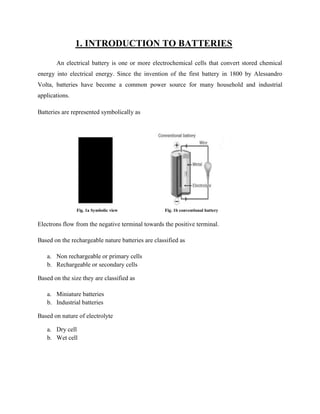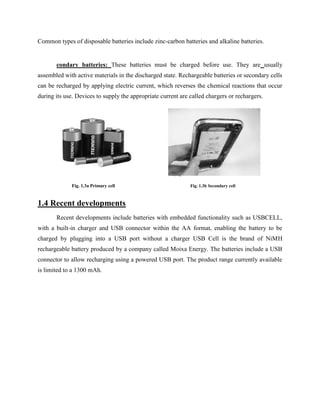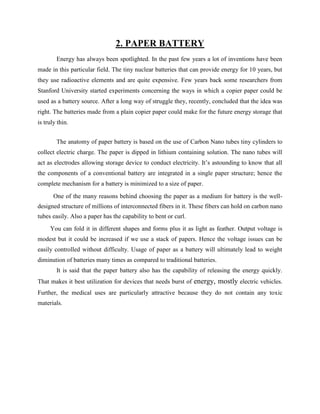New microsoft office word document (6)
- 1. 1. INTRODUCTION TO BATTERIES An electrical battery is one or more electrochemical cells that convert stored chemical energy into electrical energy. Since the invention of the first battery in 1800 by Alessandro Volta, batteries have become a common power source for many household and industrial applications. Batteries are represented symbolically as Fig. 1a Symbolic view Fig. 1b conventional battery Electrons flow from the negative terminal towards the positive terminal. Based on the rechargeable nature batteries are classified as a. Non rechargeable or primary cells b. Rechargeable or secondary cells Based on the size they are classified as a. Miniature batteries b. Industrial batteries Based on nature of electrolyte a. Dry cell b. Wet cell
- 2. Common types of disposable batteries include zinc-carbon batteries and alkaline batteries. condary batteries: These batteries must be charged before use. They are usually assembled with active materials in the discharged state. Rechargeable batteries or secondary cells can be recharged by applying electric current, which reverses the chemical reactions that occur during its use. Devices to supply the appropriate current are called chargers or rechargers. Fig. 1.3a Primary cell Fig. 1.3b Secondary cell 1.4 Recent developments Recent developments include batteries with embedded functionality such as USBCELL, with a built-in charger and USB connector within the AA format, enabling the battery to be charged by plugging into a USB port without a charger USB Cell is the brand of NiMH rechargeable battery produced by a company called Moixa Energy. The batteries include a USB connector to allow recharging using a powered USB port. The product range currently available is limited to a 1300 mAh.
- 3. Fig. 1.4 USB cell 1.5 Life of battery Even if never taken out of the original package, disposable (or "primary") batteries can lose 8 to 20 percent of their original charge every year at a temperature of about 20°– 30°C. [54] This is known as the "self-discharge" rate and is due to non-current-producing "side" chemical reactions, which occur within the cell even if no load is applied to it. The rate of the side reactions is reduced if the batteries are stored at low temperature, although some batteries can be damaged by freezing. High or low temperatures may reduce battery performance. This will affect the initial voltage of the battery. For an AA alkaline battery this initial voltage is approximately normally distributed around 1.6 volts. Rechargeable batteries self-discharge more rapidly than disposable alkaline batteries, especially nickel-based batteries a freshly charged NiCd loses 10% of its charge in the first 24 hours, and thereafter discharges at a rate of about 10% a month. Most nickel- based batteries are partially discharged when purchased, and must be charged before first use.
- 5. 2. PAPER BATTERY Energy has always been spotlighted. In the past few years a lot of inventions have been made in this particular field. The tiny nuclear batteries that can provide energy for 10 years, but they use radioactive elements and are quite expensive. Few years back some researchers from Stanford University started experiments concerning the ways in which a copier paper could be used as a battery source. After a long way of struggle they, recently, concluded that the idea was right. The batteries made from a plain copier paper could make for the future energy storage that is truly thin. The anatomy of paper battery is based on the use of Carbon Nano tubes tiny cylinders to collect electric charge. The paper is dipped in lithium containing solution. The nano tubes will act as electrodes allowing storage device to conduct electricity. It’s astounding to know that all the components of a conventional battery are integrated in a single paper structure; hence the complete mechanism for a battery is minimized to a size of paper. One of the many reasons behind choosing the paper as a medium for battery is the well- designed structure of millions of interconnected fibers in it. These fibers can hold on carbon nano tubes easily. Also a paper has the capability to bent or curl. You can fold it in different shapes and forms plus it as light as feather. Output voltage is modest but it could be increased if we use a stack of papers. Hence the voltage issues can be easily controlled without difficulty. Usage of paper as a battery will ultimately lead to weight diminution of batteries many times as compared to traditional batteries. It is said that the paper battery also has the capability of releasing the energy quickly. That makes it best utilization for devices that needs burst of energy, mostly electric vehicles. Further, the medical uses are particularly attractive because they do not contain any toxic materials.



![Fig. 1.4 USB cell
1.5 Life of battery
Even if never taken out of the original package, disposable (or "primary") batteries can lose 8
to 20 percent of their original charge every year at a temperature of about 20°–
30°C. [54] This is known as the "self-discharge" rate and is due to non-current-producing
"side" chemical reactions, which occur within
the cell even if no load is applied to it. The rate of the side reactions is reduced if the batteries
are stored at low temperature, although some
batteries can be damaged by freezing. High or low temperatures may reduce battery
performance. This will affect the initial voltage of the battery. For an AA alkaline battery this
initial voltage is approximately normally distributed around 1.6 volts.
Rechargeable batteries self-discharge more rapidly than disposable alkaline batteries, especially
nickel-based batteries a freshly charged NiCd loses 10% of its charge in the first 24 hours, and
thereafter discharges at a rate of about 10% a month. Most nickel-
based batteries are partially discharged when purchased, and must be charged before first
use.](https://image.slidesharecdn.com/newmicrosoftofficeworddocument6-130316031918-phpapp02/85/New-microsoft-office-word-document-6-3-320.jpg)

